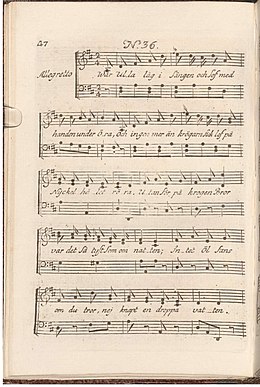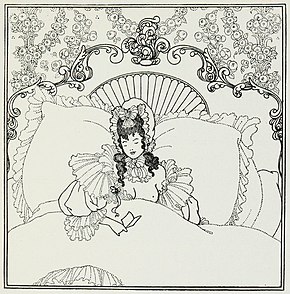Vår Ulla låg i sängen och sov
| "Vår Ulla låg i sängen och sov" | |
|---|---|
| Art song | |
 First page of sheet music for the 1810 edition | |
| English | Our Ulla lay in bed and slept |
| Written | 1773–1776[1] |
| Text | poem by Carl Michael Bellman |
| Language | Swedish |
| Melody | Prins Fredric, a contredanse |
| Published | 1790 in Fredman's Epistles |
| Scoring | voice, cittern, and horn |
Vår Ulla låg i sängen och sov (Our Ulla lay in bed and slept) is Epistle No. 36 in the Swedish poet and performer Carl Michael Bellman's 1790 song collection, Fredman's Epistles. The epistle is subtitled "Rörande Ulla Winblad's flykt" (Concerning Ulla Winblad's flight). It begins with the innkeeper peeping through the keyhole to her bedroom and whispering with his friends as she sleeps, slowly waking up. Then she dresses ornately and enters the tavern, delighting the menfolk until she is suddenly arrested.
The epistle has been praised as a perfect example of Bellman's rococo style, narrated with a mix of earthy and poetic detail.[2]
Background
Epistle
Music and verse form
The song has nine stanzas, each of eighteen lines. It is in
The source of the melody is a contredanse called Prins Fredric.[1][13]
Lyrics

The song was written sometime between 1773 and 1776.[1] The epistle begins with the innkeeper whispering with his friends and peeping through the keyhole to Ulla bedroom as she lies asleep, gradually waking up. She stirs uneasily, wakes, and adorns herself in a manner "worthy of a Marie Antoinette": she "sprinkles her bosom 'with wine and rosewater', twines a pearl bracelet round her wrist and adorns her locks with a bo-peep hat".[2] She enters the tavern, delighting the menfolk with her charms, and drinks a brandy with a lump of sugar. Then, disaster strikes: four ragged bailiffs arrive, arrest her, ignoring her shrieks, and lead her away.[2]
| Carl Michael Bellman, 1770 | Paul Britten Austin, 1977[14] |
|---|---|
Men himmel ach! hur bytes alt om! |
But heav'ns, alas! Ah, gods, what a change! |
Reception and legacy

The epistle is in the opinion of Bellman's biographer, Paul Britten Austin, "a perfect—perhaps the perfect—example of Bellman at his most rococo".[2] He writes that it is narrated with "a delightful blend of earthy and poetic detail, shimmering with humour".[2] In his view, it is a "splendid poem, wherein Bellman shows immeasurable artistry, balance, and subtlety of effect".[2] He states that it cannot, as earlier proposed, have been a response to William Hogarth's A Rake's Progress, and has none of Hogarth's moralization, but could perhaps be echoing Alexander Pope's The Rape of the Lock.[2]
Carina Burman writes in her biography of Bellman that people have from time to time wanted to change a word in the Epistle. The Bellman interpreter Cornelis Vreeswijk for some reason sings it with the word vattenglas ("water-glass") in place of Ulla's Bränvins-glas, a brandy-glass. The poet Per Daniel Amadeus Atterbom took issue with the word dunder, lit. "thunder", meaning a fart that Ulla releases as she climbs into bed, pulling the quilt over her head. Burman comments that it is interesting that Atterbom took exception to a bodily function rather than sex.[15]
The Epistle has been recorded by Mikael Samuelson and by Cornelis Vreeswijk.[16]
Notes
- ^ Bellman has halta, "lame".
References
- ^ a b c "Fredmans Epistel N:o 36: Kommentar tab". Bellman.net. Retrieved 11 December 2021.
- ^ a b c d e f g h Britten Austin 1967, pp. 82–84.
- ^ Bellman 1790.
- ^ Bellman Society. Archived from the originalon 10 August 2015. Retrieved 25 April 2015.
- ^ "Bellman in Mariefred". The Royal Palaces [of Sweden]. Archived from the original on 21 June 2022. Retrieved 19 September 2022.
- ISBN 978-0131369207.
- ^ Britten Austin 1967, pp. 60–61.
- ^ Britten Austin 1967, p. 39.
- ^ Britten Austin 1967, pp. 81–83, 108.
- ^ Britten Austin 1967, pp. 71–72 "In a tissue of dramatic antitheses—furious realism and graceful elegance, details of low-life and mythological embellishments, emotional immediacy and ironic detachment, humour and melancholy—the poet presents what might be called a fragmentary chronicle of the seedy fringe of Stockholm life in the 'sixties.".
- ^ Britten Austin 1967, p. 63.
- ^ Hassler & Dahl 1989, pp. 91–97.
- ^ Massengale 1979, p. 177.
- ^ Britten Austin 1977, p. 50.
- ^ Burman 2019, pp. 458, 476.
- ^ Hassler & Dahl 1989, pp. 281–283.
Sources
- Bellman, Carl Michael (1790). Fredmans epistlar. Stockholm: By Royal Privilege.
- ISBN 978-3-932759-00-0.
- OCLC 186784336.
- ISBN 978-9100141790.
- Hassler, Göran; ISBN 91-7448-742-6. (contains the most popular Epistles and Songs, in Swedish, with sheet music)
- ISBN 91-7736-059-1. (with facsimiles of sheet music from first editions in 1790, 1791)
- ISBN 91-554-0849-4.
External links
- Text of Epistle 36 on Bellman.net


